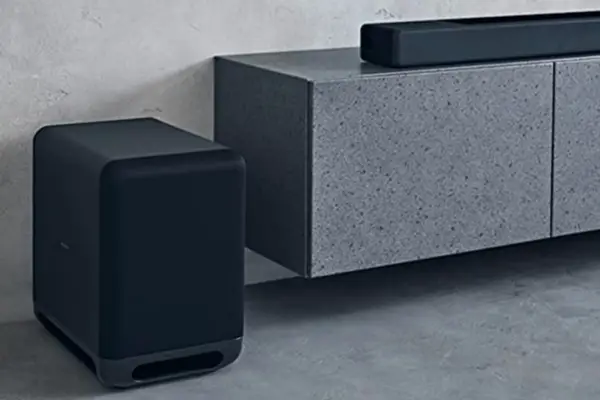How to Connect a Subwoofer to a Soundbar
Are you looking to upgrade your home theater system but unsure about how to connect a subwoofer to a soundbar? This article will guide you through the process, enhancing your audio experience by adding powerful, room-filling bass to your current setup.
Understanding the importance of a subwoofer in the audio world is crucial in appreciating the depth it brings to your sound. This guide aims to shed light on the step-by-step process of integrating a subwoofer with your soundbar, promising to elevate your every listening experience.

Understanding the Basics
Before diving into the connection process, it’s essential to have a fundamental understanding of what a subwoofer is and how a soundbar functions.
A subwoofer is a speaker specifically designed to reproduce low-pitched audio frequencies, also known as bass. Its role is to provide depth and body to the overall sound, making the audio experience more immersive and lifelike.
On the other hand, a soundbar is a type of loudspeaker that projects audio from a wide enclosure. It is much wider than it is tall, partly for acoustical reasons, and partly so it can be mounted above or below a display device, like a television or a computer monitor.
While some soundbars come with built-in subwoofers, they often can’t match the power and depth provided by a separate, dedicated subwoofer. This is where our guide on how to connect a subwoofer to your soundbar becomes beneficial.
Necessary Equipment for Connecting a Subwoofer and Soundbar
To successfully connect a subwoofer to a soundbar, there are several pieces of equipment you’ll need. Each plays a crucial role in the process, and understanding their functions can aid in setting up the system smoothly:
- Powered Subwoofer: This is the main component responsible for producing those low-frequency sounds. A powered subwoofer comes with an in-built amplifier, which drives the woofer and relieves your main speakers from producing bass, thus enhancing the overall sound quality.
- Soundbar with an Optical Output: The optical output on your soundbar is the source of the audio signal. It’s essential for transmitting the audio from your soundbar to the subwoofer. This feature might not be present on all soundbars, so make sure yours has one before proceeding.
- Digital-to-Analog Audio Converter: This device plays the critical role of converting the digital audio signal from the optical output into an analog signal. The subwoofer, which works on analog signals, then takes this output from the converter.
Understanding these pieces of equipment will make the process of connecting a subwoofer to your soundbar more straightforward and hassle-free.
How to Connect a Subwoofer to a Soundbar
Connecting a subwoofer to a soundbar may seem daunting at first, but by following these steps, the process becomes straightforward and manageable:
- Identify the Optical Output: The first step involves locating the optical output on your soundbar. This output allows the transmission of the audio signal to the subwoofer.
- Connect to the Digital-to-Analog Audio Converter: Next, use an optical cable to connect the optical output of your soundbar to the digital-to-analog audio converter. This device will convert the digital audio signal into an analog one, which can be processed by your subwoofer.
- Connecting the Subwoofer: Once the digital-to-analog audio converter is connected and functioning, connect the outputs from the converter to the subwoofer using appropriate audio cables. This will allow the analog audio signals to be processed by the subwoofer’s amplifier, enhancing your audio output.
- Tuning the Subwoofer: After connecting the subwoofer, there might be a slight delay in the audio output due to syncing issues. To minimize this delay, it’s recommended to set the crossover frequency on your subwoofer below 80 hertz.
- Managing Audio Levels: The final step involves fine-tuning your audio setup. Adjust the volume and crossover frequency on your subwoofer based on your listening preferences. You can experiment with these settings to find the best balance for your listening experience.
By following these steps, you should be able to successfully connect a subwoofer to your soundbar and enhance your audio system with rich, powerful bass.
Watch this how to video…
How to Connect a Subwoofer to a Soundbar
Connecting a subwoofer to a soundbar can transform your home audio experience by adding a depth of sound and a richness to your audio quality that was previously missing.
Remember that every sound system is unique, and the optimal settings for your subwoofer will vary based on your room acoustics and personal preferences. Don’t be afraid to spend some time experimenting with the volume and crossover settings on your subwoofer to find the best sound balance for your environment.
While this process may need a bit of patience and fine-tuning, the end result of a robust, high-quality audio experience is well worth the effort. So, don’t hesitate to dive in and start enjoying the powerful bass that a subwoofer can bring to your home theater system.

I am a passionate and skilled car audio enthusiast with 15 years of experience in the industry. My journey started when I replaced my first set of factory car speakers, sparking a deep love for high-quality sound. Since then, I have worked as a representative for renowned brands like Kenwood and Alpine.
With a background in both retail and distribution, I have developed a comprehensive understanding of the car audio market. Currently a certified (MECP) installer in the Mobile Electronics industry, my expertise lies in delivering top-notch audio installations. My knowledge, coupled with my genuine passion, makes me the go-to professional for all car audio needs.


